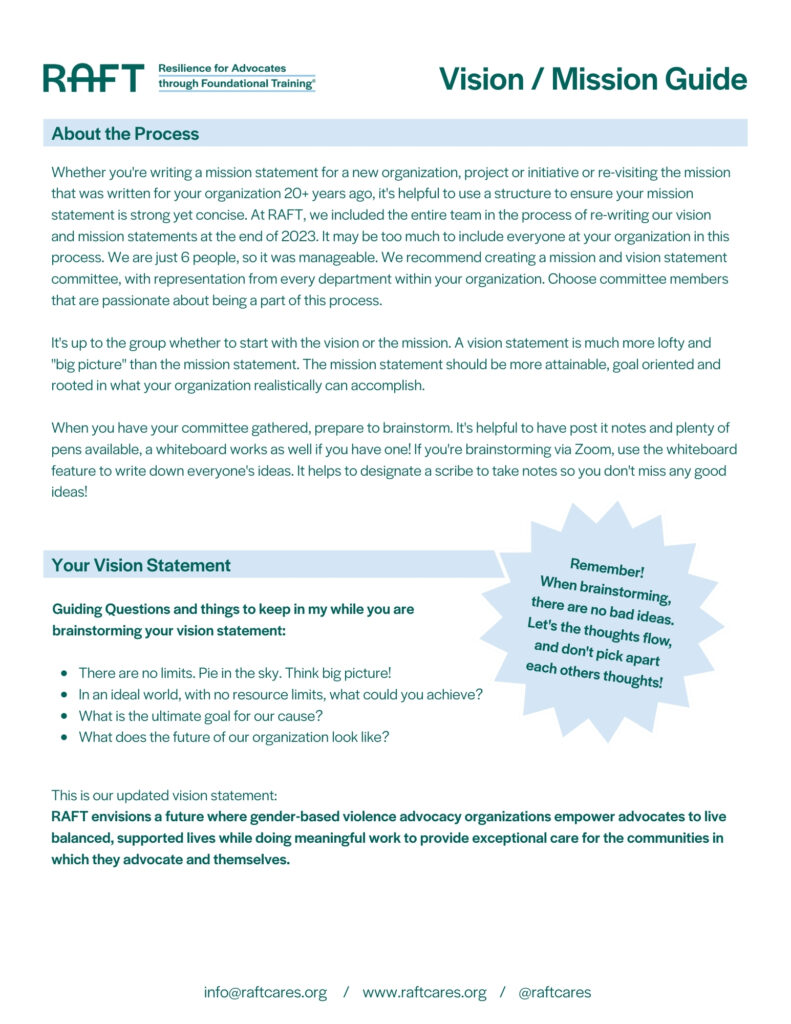Refresh Your Mission and Vision Statement — Collectively
Sophie Strachan, October 23, 2025
How long has it been since your mission statement was written? Does it still align with the values of the current staff and leadership? Does it reflect what your organization is actually doing? And is your mission truly attainable or is it more like a vision statement?
Refreshing your mission and vision statement as a whole organization is an excellent way to increase staff morale, re-invigorate enthusiasm for the work, and cultivate supportive teamwork.
Whether you're writing a mission statement for a new organization, project, or initiative -- or re-visiting one written 20+ years ago, it’s helpful to follow a structure that ensures it’s strong yet concise. At RAFT, we included the entire team in the process of rewriting our mission and vision statements at the end of 2023. With a team of 6, it was manageable, but it might be too much to include everyone in your organization in this process.
For larger organizations, we recommend creating a mission and vision statement committee with representation from every department. Choose committee members who are passionate about the process and give them the space to ensure your statement reflects both your values and your work today.
Why do it collectively?
Everyone in your organization has a stake in your mission, because they are passionate about the work your organization does. Including a wide range of voices ensures you won’t miss valuable perspectives. After all, an organization can look very different from behind a desk than it does from the frontlines with clients.
When staff across roles and departments are invited to share their input, it not only strengthens the statement itself but also deepens commitment to living it out. A mission people help shape is a mission they take ownership of. Pairing leadership voices with those closest to the work ensures the statement reflects both the vision from above and the reality on the ground.
In advocacy, where burnout and overwhelm are common, a shared mission can serve as a powerful anchor. When shaped collectively, it becomes more than words on a wall - it becomes a daily reminder of purpose and a guidepost for decision-making.

The Process:
So, how do you actually refresh your mission and vision? Once you’ve committed to revisiting them, it helps to follow a process that keeps things structured, collaborative, and clear. At RAFT, we found that using a simple framework made it easier to gather ideas, involve the right people, and turn big conversations into concise, powerful statements.
Here’s a process you can adapt for your own organization:
1.) Gather your committee:
Decide who will be involved in shaping your mission and vision. At RAFT, we were able to include all six staff members, but larger organizations may need to form a representative committee. Choose members from across departments and levels who are both passionate and connected to the work. This helps ensure your statements reflect both leadership’s vision and the realities on the ground.
2.) Now get started:
It's up to the group whether to start with the vision or the mission.
- A vision statement is much loftier and "big picture” - it paints the ideal future you’re working toward.
- A mission statement should be more attainable, goal oriented, and rooted in what your organization realistically can accomplish or work towards.
3.) Brainstorm together:
Once your committee is gathered, prepare to brainstorm. Provide plenty of sticky notes, pens, and a whiteboard if meeting in person. If you're brainstorming via Zoom, use the whiteboard feature to write down everyone's ideas. It helps to designate a scribe to take notes, so you don't miss any good ideas!
Remember: when brainstorming- there are no bad ideas, there are no limits! Think big and let the thoughts flow without judgement.
Guiding questions for the vision statement:
- What is our ultimate “pie in the sky” goal?
- What do we want the future of our organization to look like?
- What is the ultimate goal for our cause?
👉 Here’s RAFT’s updated vision statement as an example:
RAFT envisions a future where gender-based violence advocacy organizations empower advocates to live balanced, supported lives while doing meaningful work to provide exceptional care for the communities in which they advocate and themselves.
It can be easier to start with the idealistic dream of the ultimate end goal. But if your group is having trouble dreaming, start with the mission... To craft your mission statement, spend time answering and brainstorming around these four questions:
Guiding questions for a Mission Statement:
- Who are we? (As an organization, as a group of people, occupation, identity) - More than likely you will end up using your organization's name in your statement, but answering this question more abstractly can help identify values or connections.
- What do we do? (What are your services? What are your programs? Do you work with clients? Do you spread awareness or advocate for rights? Do you stand for a specific cause? If this is for a program - what will the program do? What is offered? Be specific!)
- Why do we do it? (What is the impact of your programs? What is the point? What are your values? Why is this important? Who benefits from your offerings?)
- How do we do it? (What are the logistics of your services? How are your programs implemented? Do you have a hotline service? Walk-ins? Are you only virtual or by appointment?)
4.) Craft your statements:
Now that you have a ton of answers to these questions, one or two people should volunteer to synthesize everything you've collected during the brainstorm. These individuals should feel comfortable wordsmithing and capturing the spirit of the group’s ideas in a clear, concise way. The goal of these statements isn't to include every detail, or every thought, but to capture the essence of your organization’s work, values, and purpose.
Generally, the format of your mission statement should follow this:
Who does What because Why through How.
👉 RAFT’s updated mission statement:
RAFT supports organizations and advocates to cultivate human-centered workspaces through foundational wellness practices, resources, and training to build resilience and promote a positive gender-based violence advocacy ecosystem.
5.) Get feedback:
Next, when your writer(s) has a draft statement, it should be shared with the committee for feedback. Be clear in the request for feedback:
- When is feedback due?
- How should it be submitted?
- Are there words or phrases that cannot be changed?
(Tip: See RAFT’s SMART Request worksheet for more on requesting clear, actionable feedback.)
6.) Share It with the World!
Finally, once finalized and approved by leadership or your board, share your new mission and vision widely. Post them on your website, social media, flyers, and in marketing materials. Most importantly, weave them into the daily life of your organization - make sure your mission and vision aren’t just written, but lived.
Refreshing your mission and vision isn’t just about crafting the right words - it’s about creating shared direction and purpose. When your team has a hand in shaping these statements, they become more than polished sentences on a page. They become a living compass that guides decisions, fuels connection, and keeps everyone grounded in the heart of your work.

👉 Use our free Vision and Mission statement guide to help your organization with your process!








